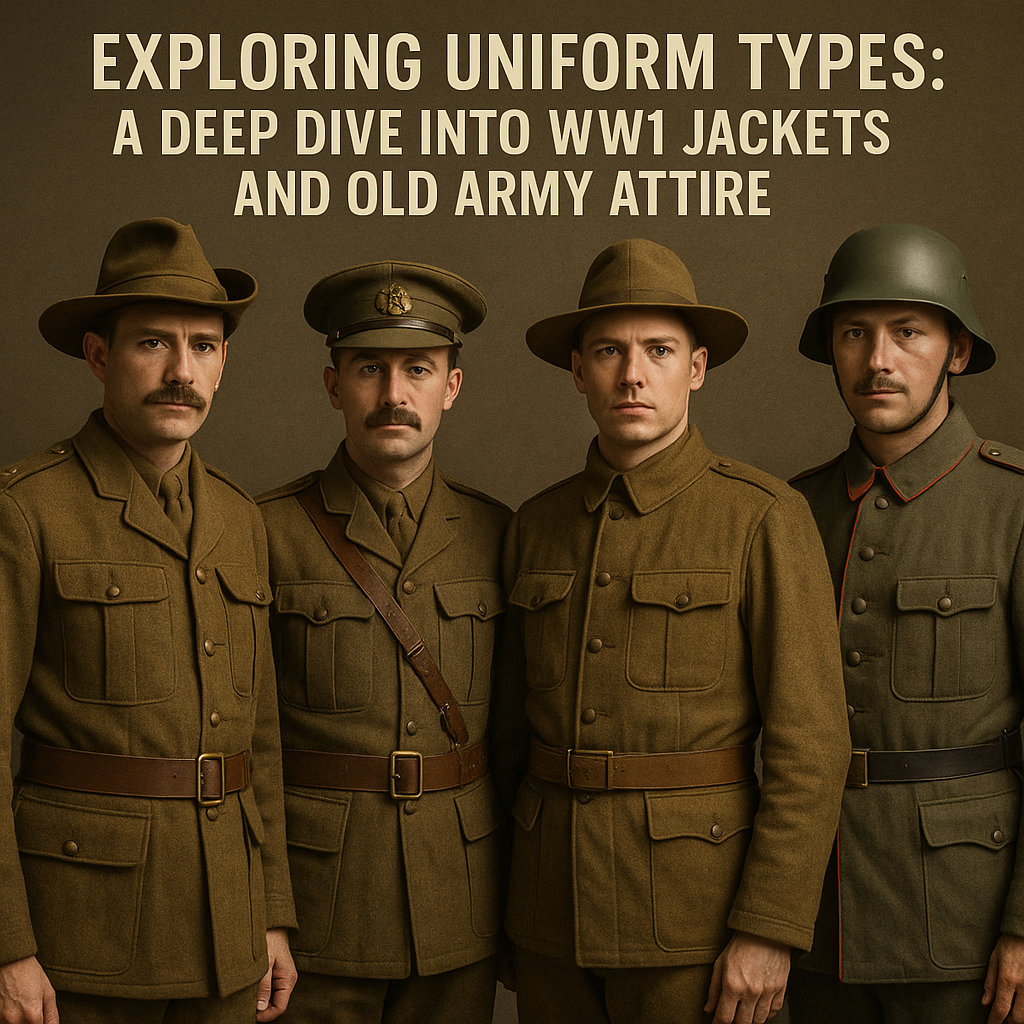
"Exploring Uniform Types: A Deep Dive into WW1 Jackets and Old Army Attire"
Published on May 15, 2025
Uniform Types: A Journey Through World War 1 Military Attire
The First World War wasn't just a landmark in global conflict—it was also a defining moment for military uniforms. The outfits soldiers wore during this period were designed for both function and national pride. Understanding uniform types from World War 1—especially iconic pieces like the WW1 jacket, old army uniforms, and ANZAC uniform styles—gives us deep insight into the era’s military and cultural history.
The Evolution of Military Uniforms in WW1
At the outbreak of WWI in 1914, most nations still retained 19th-century styles in their uniforms. However, as trench warfare demanded more practical, durable gear, military attire underwent rapid transformation.
Key factors driving uniform changes included:
- Climate and terrain of battlefields
- Camouflage and concealment needs
- Economic and material shortages
- Soldier comfort and mobility
Let’s explore the key uniform types worn during the First World War.
1. The British Army Uniform: Sturdy and Symbolic
TheFirst World War British uniform was designed to balance practicality and national identity. Early versions featured:
- Service Dress Tunic: A heavy wool khaki tunic with pleated breast pockets and a high collar.
- WW1 Jacket (1902 Pattern): Made from thick wool, these jackets were built for durability and insulation during trench warfare.
- Puttees: Long woolen strips wrapped around the lower legs to offer support and protection from mud and cold.
Over time, the British uniform was simplified. By mid-war, the stiff collars were replaced by open collars for comfort, and buttons were made of plastic or other substitutes due to metal shortages.
2. ANZAC Uniform WW1: Identity on Foreign Soil
The ANZACs (Australian and New Zealand Army Corps) played a pivotal role in battles such as Gallipoli and the Western Front. Their uniforms mirrored the British in structure but often included subtle distinctions:
- Slouch Hat: The iconic Australian slouch hat, often adorned with a rising sun badge, symbolized national pride.
- Wool Tunics and Breeches: Similar in cut to British counterparts but sometimes modified based on climate or supply.
- ANZAC Badges and Insignia: Unit-specific markings distinguished these soldiers from other Commonwealth forces.
The ANZAC uniform represents not only military utility but also the emergence of national identity during the Great War.
3. The Classic WW1 Jacket: A Collector’s Gem
The WW1 jacket is perhaps the most sought-after piece among collectors and enthusiasts. Known for its:
- Rugged woolen construction
- Reinforced seams and high necklines
- Buttoned breast pockets and waist belts
These jackets were more than clothing—they were a soldier's shield against the brutal cold and rain of the trenches. Today, they serve as powerful historical artifacts.
Many original WW1 jackets still survive in museums or private collections, often featuring:
- Regiment tags
- Repair stitching from the battlefield
- Personalized markings from soldiers
4. Army Uniform Old: A Global Look
While the British and ANZAC uniforms are well-documented, every participating nation brought unique elements to the battlefield. If you’re fascinated by army uniform designs, here’s a glimpse of a few noteworthy types:
- French Horizon Blue Uniform: A soft blue wool uniform that replaced earlier red-trousered outfits. Though stylish, it was not ideal for concealment.
- German Feldgrau (Field Grey): Practical and easily camouflaged, the German uniform set the standard for modern military apparel.
- U.S. Doughboy Uniform: Entering the war in 1917, American troops wore wool tunics and the famous "Montana Peak" campaign hats.
Each country’s uniform tells a different story—one of resourcefulness, pride, and adaptation.
5. The Role of Uniforms in Battlefield Psychology
Uniforms were more than military tools—they shaped morale and discipline. A cohesive uniform:
- Fostered unity among troops
- Projected power and professionalism
- Helped identify friend from foe
The psychological impact of a well-fitted World War 1 jacket cannot be overstated. Soldiers often took pride in maintaining their gear, even in muddy trenches.
6. Reenactment, Collecting, and Preservation
Today, interest in WW1 uniforms spans:
- Historical reenactments
- Museum displays
- Private collections
- TV and film productions
If you’re looking to purchase or learn about WW1 jackets or old army uniforms, websites like Paddelaters.com provide a rich resource. Whether you’re curating a personal collection or outfitting a reenactment group, authenticity and detail matter.
Our curated selection includes:
- Reproductions of 1902 pattern jackets
- ANZAC uniform pieces
- Accessories like puttees, badges, and belts
7. How to Identify Authentic WW1 Uniforms
When examining WW1 Army uniforms, watch for these details:
- Material: Authentic pieces use heavy wool with natural aging
- Markings: Check for original military stamps or soldier initials
- Construction: Look for reinforced stitching and unique button styles
- Condition: Many original uniforms show signs of field wear or repairs
These indicators help distinguish genuine articles from replicas.
Conclusion: Why Uniform Types Still Matter
Uniforms are more than clothing—they’re symbols of service, resilience, and national pride. Exploring the various uniform types from the First World War, from the ANZAC uniform WW1 to the rugged WW1 jacket, gives us a window into the past.
Whether you're a historian, reenactor, or enthusiast, the legacy of old army uniforms lives on. They remind us of the sacrifices made and the global impact of a war that shaped the 20th century.
